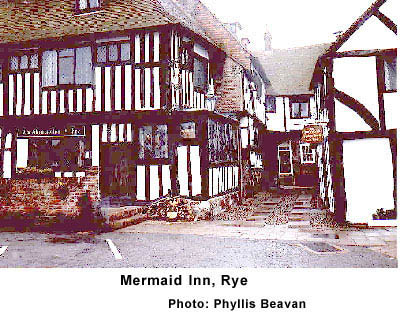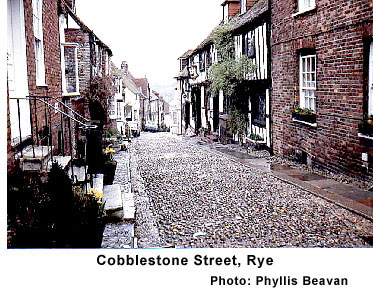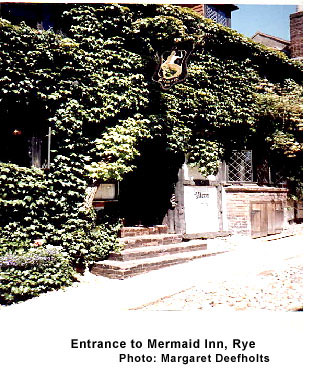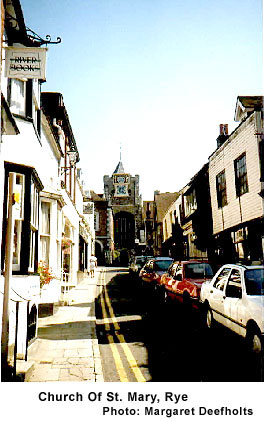 “Go
to Rye.” urges my sister just before my family and I take off for Britain,
“All cobblestones and medieval atmosphere. You’ll love it!” So armed with
a BritRail pass, and a sheaf of information about this Cinque Port, we
take off from London on a day trip to the Sussex coast.
“Go
to Rye.” urges my sister just before my family and I take off for Britain,
“All cobblestones and medieval atmosphere. You’ll love it!” So armed with
a BritRail pass, and a sheaf of information about this Cinque Port, we
take off from London on a day trip to the Sussex coast.
Rye goes back to the time of Alfred the Great, who in the 9th century recognised the importance of defending Britain’s shoreline, and founded what would eventually become the invincible British Navy. William the Conqueror took this a step further and designated strategic towns along the Sussex coastline as “Cinque Ports.” whose prime objectives were shipbuilding and naval defence. In return, these Ports received royal patronage, financial assistance and favourable tax breaks. (Are you listening to this Ottawa?) By the Middle Ages, Rye was flourishing. Not just as a naval base, but as a thriving smugglers’ paradise as well.
 It
takes no stretch of imagination to picture ‘old’ Rye. In fact, the town
is like a movie stage set where an elegant carriage and pair might well
appear around a corner, clattering over cobblestone streets, scattering
aside dogs, domesticated pigs, chickens, children and long-skirted housewives,
in its wake. We stroll through a labyrinth of narrow lanes, past 18th
century half-timbered houses which lean towards each other as if whispering
secrets of their past; some wear crooked stove-pipe chimneys and pointed
gable hats, others spill scarlet geraniums from window boxes perched against
their bay-windows.
It
takes no stretch of imagination to picture ‘old’ Rye. In fact, the town
is like a movie stage set where an elegant carriage and pair might well
appear around a corner, clattering over cobblestone streets, scattering
aside dogs, domesticated pigs, chickens, children and long-skirted housewives,
in its wake. We stroll through a labyrinth of narrow lanes, past 18th
century half-timbered houses which lean towards each other as if whispering
secrets of their past; some wear crooked stove-pipe chimneys and pointed
gable hats, others spill scarlet geraniums from window boxes perched against
their bay-windows.
Half way along Mermaid Street is one of Rye’s oldest and most well known hostelries: the 16th century “Mermaid Inn”, with its mullioned windows and ivy-covered entrance archway. Tucked into its past are tales of the notorious Hawkhurst gang of cut-throat smugglers who used to gather there to plot, drink and carouse into the wee small hours.
 Mermaid
Inn also hosted distinguished visitors and although not supported by any
hard facts, the story goes that this was where Queen Elizabeth I slept
the night when she visited the town in 1573, after which she bestowed
on it the title of “Royal Rye”. Mermaid Inn still lives up to its reputation,
its oak-beamed ceilings and stone fireplaces lending it an aura of old
world graciousness.
Mermaid
Inn also hosted distinguished visitors and although not supported by any
hard facts, the story goes that this was where Queen Elizabeth I slept
the night when she visited the town in 1573, after which she bestowed
on it the title of “Royal Rye”. Mermaid Inn still lives up to its reputation,
its oak-beamed ceilings and stone fireplaces lending it an aura of old
world graciousness.
We browse through antique and craft shops with frilly lace curtains framing their windows, goggle at wondrously carved chess sets and peek inside medieval ale- houses which, after dark in olden days, must have been noisy with music, laughter and braggadocio of sea faring adventurers and rogues. Our route takes us to Landgate a 14th century fortified archway which was the only entrance into the town when the sea bordered it on three sides. The walls are massive and the parapets have slits through which boiling oil was poured on the heads of unwelcome visitors.
Having their brains fried in oil, didn’t deter the French. A raiding foray in 1377 pillaged the town and burned it almost to the ground. One of the monuments that survived was the Church of St. Mary, parts of which date from 1150. Its a lovely old building with glowing stained glass windows, and it reputedly boasts one of the oldest working clocks in Britain. Built in the sixteenth century, the clock was flanked by gilt cherubs, known as Quarter Boys, which struck the bells on the quarter hour. My son and daughter climb the tower to look at the inner workings of the clock, and return to tell us that the view of the surrounding countryside from the top “is fabulous.”
 Rye
has literary associations too, and not far from the Church of St. Mary
is Lamb House, where author Henry James once lived and worked.
Rye
has literary associations too, and not far from the Church of St. Mary
is Lamb House, where author Henry James once lived and worked.
Like its receding shoreline, Rye’s nautical activities have long faded into history. But a carefully preserved relic of its past stands high above the Rother river. The Ypres Tower, a defensive fort was built in 1250, and canons still adorn the flanking wall. Once used as a jail, it is now a Museum with an eclectic collection of memorabilia.
We look down from the Ypres Tower battlements at the twentieth-century roar of traffic along a road far below us, and a stretch of land where the sea once lapped the shore. A tangy salt-laden wind whips against our faces. Behind us Rye, an enchanted town frozen in time, continues to endure, its only foreign invaders these days being tourists like us.
